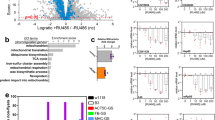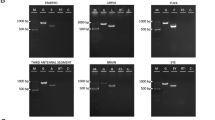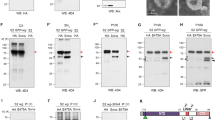Abstract
Genes controlling biological rhythms have been identified in Drosophila1,2. The best characterized of these genes is called period (per). Although wild-type flies have daily (circadian) rhythms with a periodicity of ∼24 h, pers and perl mutants have 19-h and 29-h rhythms, respectively, and per0 mutants are arrhythmic1. The pers mutation also enhances the sensitivity of the circadian clock to resetting by light stimuli3, and all three types of per mutations affect a much shorter period ultradian rhythm, the 55-s rhythm of the Drosophila courtship song4. A fragment of DNA of ∼7 kilobases (kb) encoding a 4.5-kb poly(A)+ RNA restores rhyth-micity when transduced into Drosophila carrying mutations5,6 or chromosomal deletions5 of the per locus. Here we report the sequence of this biologically active segment of DNA. The transcription unit that encodes the 4.5-kb RNA has been mapped, permitting a conceptual translation of a protein of 1,127 amino acids. Several abnormal phenotypes characterized by long-period rhythms are associated with changes in the sequence of untranslated portions of the transcription unit. The structure of some segments of the predicted protein suggests that it is a proteoglycan.
This is a preview of subscription content, access via your institution
Access options
Subscribe to this journal
Receive 51 print issues and online access
$199.00 per year
only $3.90 per issue
Buy this article
- Purchase on Springer Link
- Instant access to full article PDF
Prices may be subject to local taxes which are calculated during checkout
Similar content being viewed by others
References
Konopka, R. J. & Benzer, S. Proc. natn. Acad. Sci. U.S.A. 68, 2112–2116 (1971).
Jackson, F. R. J. Neurogenet. 1, 3–15 (1983).
Konopka, R. J. Fedn Proc. 38, 2602–2605 (1979).
Kyriacou, C. P. & Hall, J. C. Proc. natn. Acad. Sci. U.S.A. 77, 6729–6733 (1980).
Bargiello, T. A., Jackson, F. R. & Young, M.W. Nature. 312, 752–754 (1984).
Zehring, W. A. et al. Cell 39, 369–376 (1984).
Melton, D. A. et al. Nucleic Acids Res. 12, 7035–7056 (1984).
Mount, S. M. Nucleic Acids Res. 10, 459–472 (1982).
Bargiello, T. A. & Young, M. W. Proc. natn. Acad. Sci U.S.A. 81, 2142–2146 (1984).
Reddy, P. et al. Cell. 38, 701–710 (1984).
Young, M. W. & Judd, B. H. Genetics 88, 723–742 (1978).
Smith, R. F. & Konopka, R. J. Molec. gen. Genet. 183, 243–251 (1981).
Kyte, J. & Doolittle, R. F. J. molec. Biol. 157, 105–132 (1982).
Eisenberg, D., Schwarz, E., Komaromy, M. & Wall, R. J. molec. Biol. 179, 125–142 (1984).
Bramson, H. N., Kaiser, E. T. & Mildvan, A. S. CRC Crit. Rev. Biochem. 15 (No. 2), 93–124 (1984).
Eskin, A., Corrent, G., Lin, C.-Y. & McAdoo, D. J. Proc. natn. Acad. Sci. U.S.A. 79, 660–664 (1982).
Eskin, A. & Takahashi, J. S. Science 220, 82–84 (1983).
Lipman, D. J. & Pearson, W. R. Science 227, 1435–1441 (1985).
Shin, H. S., Bargiello, T. A., Clark, B. T., Jackson, F. R. & Young, M. W. Nature 317, 445–448 (1985).
Bourdon, M. A., Oldberg, A., Pierschbacher, M. & Ruoslahti, E. Proc. natn. Acad. Sci. U.S.A. 82, 1321–1325 (1985).
Robinson, H. M., Horner, K. A., Hook, M., Ogren, S. & Lindahl, U. J. biol. Chem. 253, 6687–6693 (1978).
Coudron, C., Loerner, T., Jacobson, I., Roden, L. & Schwartz, N. B. Fedn Proc. Abstr. 39, 1671 (1980).
Kornfeld, R. & Kornfeld, S. in The Biochemistry of Glycoproteins and Proteoglycans (ed. Lennarz, W. J.) 1–34 (Plenum, New York, 1980).
Sanger, F., Nicklen, S. & Coulson, A. R. Proc. natn. Acad. Sci. U.S.A. 74, 5463–5467 (1977).
Biggin, M. D., Gibson, T. J. & Hong, G. F. Proc. natn. Acad. Sci. U.S.A. 80, 3963–3965 (1983).
Staden, R. Nucleic Acids Res. 10, 4731–4751 (1982).
Dale, R. M. K., McClure, B. A. & Houchins, J. P. Plasmid 13, 31–40 (1985).
Author information
Authors and Affiliations
Rights and permissions
About this article
Cite this article
Jackson, F., Bargiello, T., Yun, SH. et al. Product of per locus of Drosophila shares homology with proteoglycans. Nature 320, 185–188 (1986). https://doi.org/10.1038/320185a0
Received:
Accepted:
Issue Date:
DOI: https://doi.org/10.1038/320185a0
This article is cited by
-
Molecular cloning and its expression of trachealess gene (As-trh) during development in brine shrimp, Artemia sinica
Molecular Biology Reports (2012)
-
Time zones: a comparative genetics of circadian clocks
Nature Reviews Genetics (2001)
-
A light-entrainment mechanism for the Drosophila circadian clock
Nature (1996)
-
Circadian rhythm and theper ACNGGN repeat in the mole rat,Spalax ehrenbergi
Behavior Genetics (1996)
-
Mutational mechanisms, phylogeny, and evolution of a repetitive region within a clock gene ofDrosophila melanogaster
Journal of Molecular Evolution (1996)
Comments
By submitting a comment you agree to abide by our Terms and Community Guidelines. If you find something abusive or that does not comply with our terms or guidelines please flag it as inappropriate.



